LOURMARIN
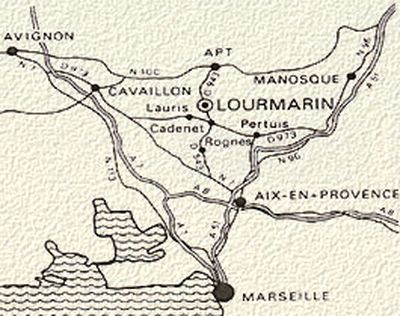 |
|
THE VILLAGE Lourmarin is a village in the east of the department of Vaucluse in the Provence-Alpes-Côte d'Azur region in southeastern France. It's located in the heart of the Luberon Regional Park in Provence, at the foot of the Luberon Massif. |
|
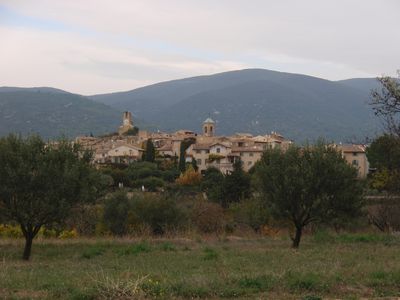 Lourmarin, crouched at the foot of the Luberon |
 The village and the Protestant temple viewed from the castle |
|
|
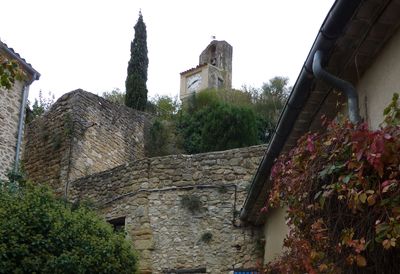 The "Castellas" |
|
| Populated ever since the Neolitic era, pillages and plague drove its inhabitants away in the 14th century. The village was populated again in the 15th century thanks to the arrival of the Waldenses (followers of the beliefs of Pierre Vaudès). The repression that fell on these laymen who had embraced the ideas of the Reformation, led to the destruction of the village in 1945. Lourmarin only returned to life in the 17th century with the establishment of silkworm nurseries and silk manufacturing. The village, with just over 1,100 inhabitants today, and which is classified as one of the "Most beautiful villages in France", has retained all its charm. |  |
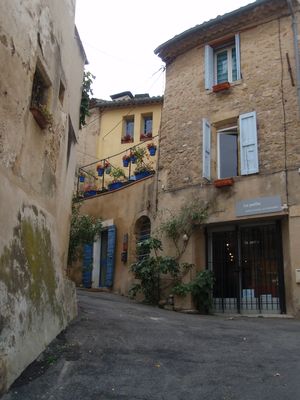 |
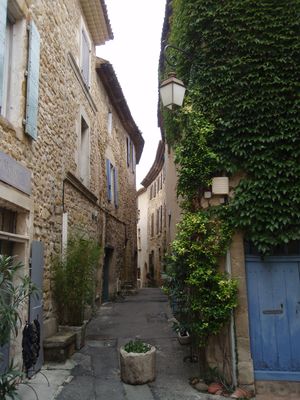 |
It's a well known cultural centre where many cultural activities take place throughout the year. Lourmarin has been the home of many celebrities like Henri Bosco and Albert Camus. |
|
ALBERT CAMUS |
|
 |
Albert Camus (1913-1960) was a French author, philosopher, and journalist who was awarded the Nobel Prize for Literature in 1957 for "his important literary production, which with clear-sighted earnestness illustrates the problems of the human conscience in our times". He wrote world-famous novels such as The Stranger (1942) and The Plague (1947), plays like for instance Caligula (1938), essays like The Rebel (1951) or Reflections on the Guillotine (1957) and short stories. Although he is often referred to as a proponent of existentialism like Jean-Paul Sartre whom he met in 1947, he rejected this label. His views contributed to the rise of the philosophy known as absurdism. |
| In 1944 he founded the "French Committee for the European Federation" declaring that Europe "can only evolve along the path of economic progress, democracy and peace if the nation states become a federation". In 1947-48, he founded the Group for International Liaisons within the Revolutionary Union Movement, a group opposed to the nihilism of André Breton. He bought his last home in Lourmarin, the village he loved so much. He died in a car crash on the road to Lourmarin with his friend and publisher Michel Gallimard. He's buried, in the cemetery of Lourmarin. |
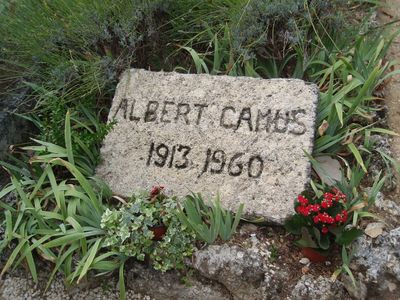 |
THE LEGEND OF THE COULOUBRE There is a legend which explains the apparition of Lourmarin: The legend of the Couloubre. |
|
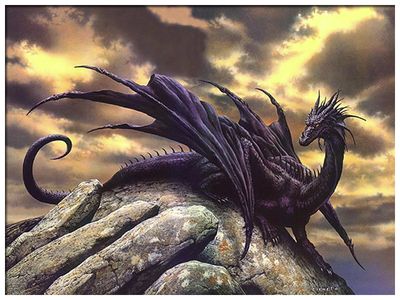 |
The Couloubre is a winged grass snake living in the Sorgue River, which mates with dragons. Very long ago, a Couloubre lived in the Luberon Mountain. It was very tall, it spat fire and it could destroy a whole village. The inhabitants were frightened and they wanted to get rid of the Couloubre but they were too fearful... That's why, after a new ravaging of a village and the kidnapping of young girls by the Couloubre, the Luberon lords asked a hermit, Veran, who was able to work grand miracles, to kill the Couloubre. He accepted and he decided to attack the incredible animal through trickery. |
| He set fire to the entry of the Couloubre's hiding place and when it went out, he hit the Couloubre on the skull with a club. The dizzy dragon flew off but Veran had hit hard and at the right place. The Animal flew over the Luberon mounts for a while before it collapsed in a big clamor. Its fall cleaved the mountain in half and its long tail created a sinuous road which still connects Apt to Lourmarin. This fracture in the mountain is called the valley of Lourmarin. Thus the village of Lourmarin came into existence. Where the blood of the Couloubre flowed, the villages are called St Veran, after the hermit who became Bishop of Cavaillon. |
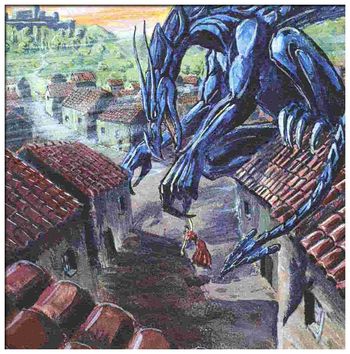 |
 |
|
The Castle of Lourmarin is the first Renaissance castle built in Provence. |
|
 |
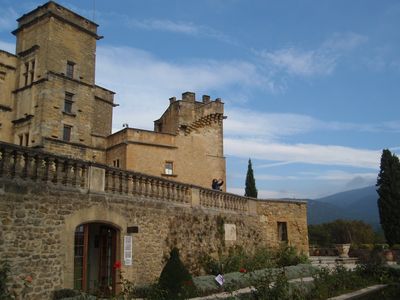 |
A little history The oldest part of the castle was built in the 15th century by Foulques d'Agoult, on the ruins of a 12th century fortress belonging to the Baux family. In 1460, Foulques d'Agoult, a rich and powerful lord, chamberlain and friend of King Rene, purchased the castle. He had a colony of Waldenses move from Piemont to Lourmarin to reclaim the land which was still marshy. At the same time, he undertook the construction of what is presently called the "Château-Vieux" (Old Castle). This Gothic castle was flanked by a round embossment tower on the north-east side and an hexagonal tower with battlements on the south-east side. In 1526, the great-grand nephew of Foulques d'Algoult, Louis Artaud de Montauban d'Agoult and his wife, Blanche de Lévis-Ventadour, decided to enlarge the old castle with the addition of the Renaissance wing, the first Renaissance building in Provence. |
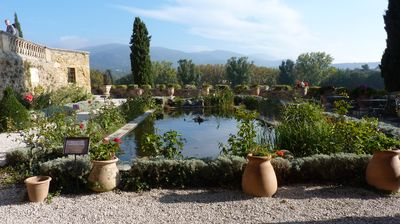 |
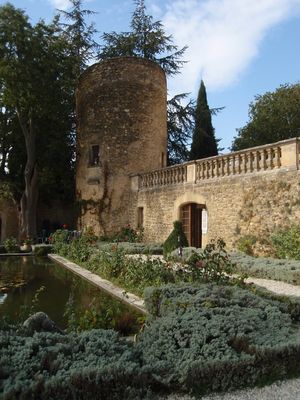 |
In 1545, the Religious war of Provence broke out. The Baron Maynier d'Oppède led a deadly expedition against the Waldenses. The castle and the village were attacked. New attacks against the castle and the local Protestants occurred until the religious wars ceased after the promulgation of the Edict of Nantes by Henry IV in 1598. In 1719, after several owners, the castle became the property of Jean-Baptiste Bruny. From then on, the different owners of the castle rarely lived in it and the castle was threatened with destruction. In 1920, just as the Castle was about to be sold to an entrepreneur for its stone, it was providentially discovered and purchased at the last minute by Robert Laurent-Vibert. Between 1921 and 1923 he had the castle restored by artisans from Lourmarin exclusively. The castle was empty when he bought it, so he furnished it with paintings and furniture collected during his numerous voyages. However, Robert Laurent-Vibert died in a road accident in 1925. In his will, he donated the castle to the "Academy of Science, Agriculture and Humanities" of Aix-en-Provence. This is how the "Foundation de Lourmarin Laurent-Vibert" was created in 1927. The castle was classified as a historic monument in 1973. |
The Château-Vieux It was built at the end of the 15th century (late Gothic style). The hexagonal tower contains a winding staircase leading to three levels of galleries. This Italian style loggia houses a library containing 28,000 books, many of which are very old and rare. |
|
 The hexagonal tower and the loggia |
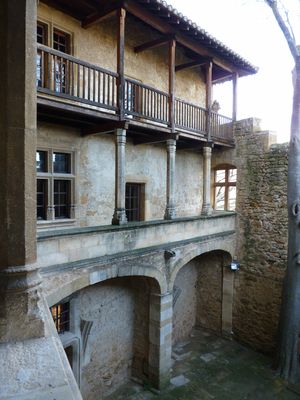 The loggia |
The Renaissance wing, the Château-Neuf The façade of the Renaissance wing, built from 1537 dominates the upper terrace. Its three levels are horizontally separated by ledges positioned at window height. The mullioned windows are aligned and outlined by Doric pilasters. |
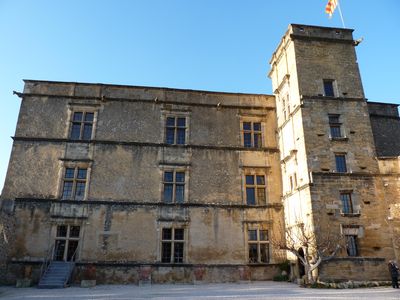 |
 |
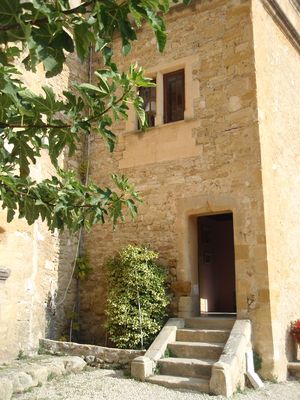 |
One enters the Renaissance wing through the rounded-arched door in the big tower. |
 |
 |
|
The Grand Staircase On passing through the door to the big tower, one cannot fail to notice the Grand Staircase. This double spiral staircase is a real architectural masterpiece. One single block of stone constitutes at the same time the step itself, the double spiral of the central column and fits into the wall of the tower. |
|
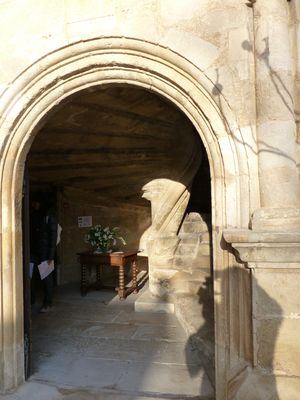 |
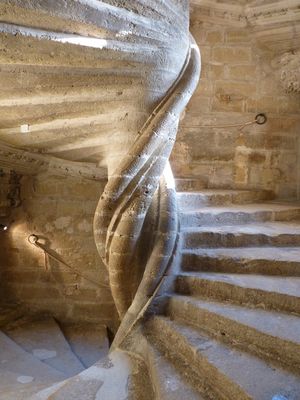 |
| It is adorned with a frieze and corner pendentives which are all different and decorated with sculpted figures or crests. The staircase ends at the top of the tower under a perfectly curved umbel-shaped vault. This cupola is supported by a slender column. |
|
 A corner pendentive |
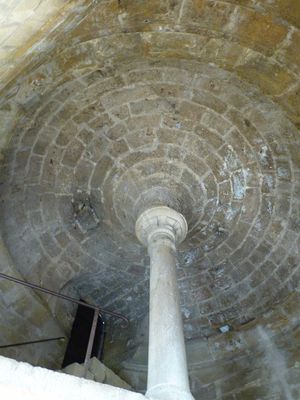 The cupola |
The Kitchen
The kitchen contains the bigger fireplace of the Château. The Lord of the Château could have an entire beef cooked in it. The brass and the copper utensils on the fireplace wall are Provencal and date back to the 17th and 18th centuries. The ones on the floor come from Morocco and the Near East. There are two dressers, one is place on a cabinet and on a sideboard from Lorraine (18th century). The second one is decorated with china from Apt. |
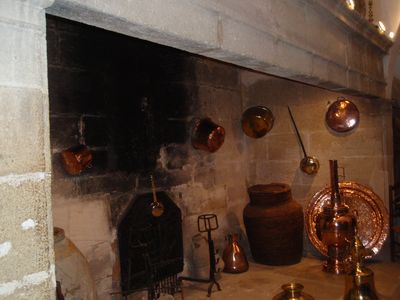 |
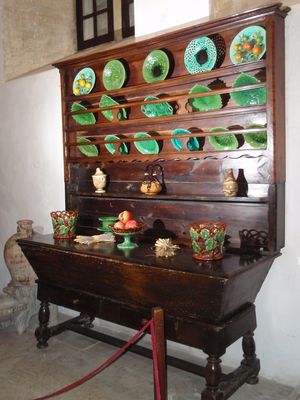 |
 China from Apt |
The Ladies'Chamber It is located on the 1st floor. It is furnished with 18th century furniture from Provence. The seat that can be seen here is typically Provencal. It's called a "radassière". |
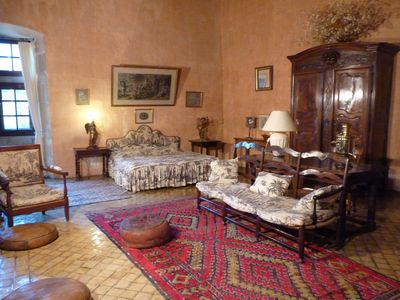 |
The Sallestre Next to the Ladies'Chamber, the Sallestre is the hall of ceremonies of the Château-Neuf where the lords would receive their guests. Most of the furniture comes from Spain. The large terracotta medallion represents the Three Graces (Greek Goddesses). |
|
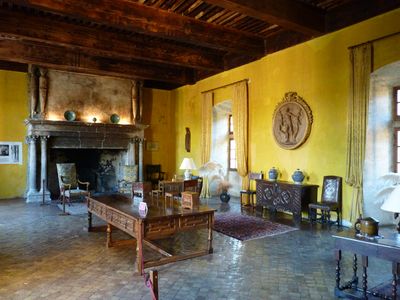 |
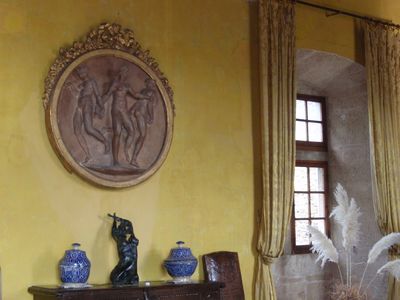 The Three Graces |
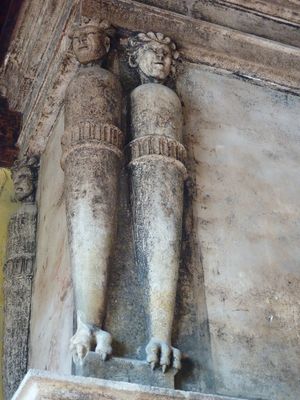 |
The monumental fireplace is adorned with statues in the shape of amphorae with clawed feet and American Indian or Inca or Aztec heads. This choice of decoration was clearly influenced by the discovery of the New World, some sixty years before the construction of the Renaissance wing. |
The Music Hall This music hall was created in 1932. It contains three keyboard instruments: a harpsichord, a pianoforte and a concert piano. The musical instruments on the wall above the pianoforte are from China and Vietnam. The room also contains African instruments. |
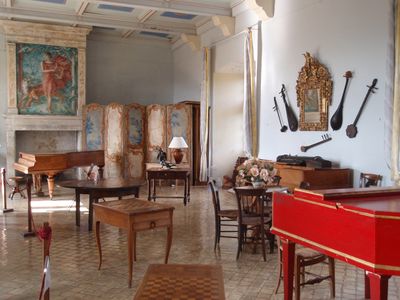 |
 |
The table and chairs are Provencal. The ceiling and painting over the fireplace are in the Art Deco style. |
| The Gentlemen's Chamber On the second floor of the Château-Neuf, this bedroom contains furniture dating from the 17th and 18th century.
|
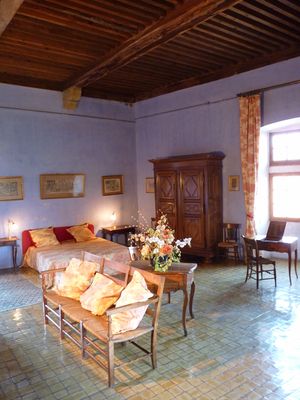 |